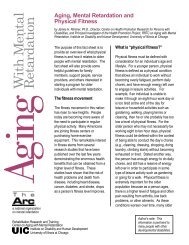Bridging the Aging and Developmental Disabilities Service ... - rrtcadd
Bridging the Aging and Developmental Disabilities Service ... - rrtcadd
Bridging the Aging and Developmental Disabilities Service ... - rrtcadd
Create successful ePaper yourself
Turn your PDF publications into a flip-book with our unique Google optimized e-Paper software.
“Two weeks ago we<br />
received a letter from <strong>the</strong><br />
state of New Jersey<br />
stating that (our son) is<br />
now number 776 on <strong>the</strong><br />
waiting list. (He) has<br />
seven more years to wait<br />
for residential services.<br />
He will be 43. We will be<br />
71. This alone is<br />
unacceptable.” (family<br />
member)<br />
o<strong>the</strong>r organ system consequences) are of concern. 11 There is a<br />
greater prevalence of obesity <strong>and</strong> a sedentary lifestyle among<br />
adults with developmental disabilities than in <strong>the</strong> general<br />
population. Their health concerns <strong>and</strong> lifestyle differences point<br />
to <strong>the</strong> need for health promotion interventions, exercise <strong>and</strong><br />
nutrition programs, health behavior education, <strong>and</strong> health<br />
screenings. Also a need exists for education of health<br />
professionals, direct support professionals, <strong>and</strong> families <strong>and</strong> o<strong>the</strong>r<br />
caregivers in addressing <strong>the</strong> health issues of adults aging with<br />
developmental disabilities.<br />
Community Participation. People of all ages with disabilities<br />
want to be part of <strong>the</strong>ir community, <strong>and</strong> such opportunities are<br />
especially important for older adults with developmental<br />
disabilities who may want to “age in place”, i.e., remain in <strong>the</strong>ir homes or in <strong>the</strong>ir jobs with<br />
adaptations for age-related changes. Some adults may want to retire from <strong>the</strong>ir job or vocational<br />
training. The aging network can be a resource for linking older people with disabilities to<br />
community activities, including volunteer work that provides opportunities to explore new<br />
interests, develop new skills, <strong>and</strong> form new friendships.<br />
Family Support. The majority of adults with developmental disabilities live with immediate<br />
family members or kin. One quarter live in <strong>the</strong>ir own household or with a spouse, <strong>and</strong> sixty<br />
percent, or nearly 2.9 million people, live with <strong>the</strong>ir family. Twenty five percent of family<br />
caregivers are age 60 <strong>and</strong> older, <strong>and</strong> ano<strong>the</strong>r 35% are in <strong>the</strong> 41-59 age range. 12 Only 12% of <strong>the</strong><br />
4.8 million Americans with developmental disabilities live in any type of formal supervised<br />
residential setting. Nationally, nearly 123,000 persons were estimated to be on waiting lists for<br />
residential services in 2009. 11 Life expectancy gains indicate <strong>the</strong>re will be growing numbers of<br />
two-generation elderly households of people with disabilities living with <strong>the</strong>ir parents. These<br />
families remain intact out of choice or due to <strong>the</strong> shortage of alternative residential options. Both<br />
generations will require supports to age in place. Often when parents can no longer provide care,<br />
siblings may be called upon to take over that role with little formal support provided to <strong>the</strong>m.<br />
Although all states now fund family support in <strong>the</strong> form of cash subsidies <strong>and</strong>/or direct services,<br />
in 2009, national family support expenditures of $3.8 billion accounted for only 7% of total<br />
national developmental disabilities expenditures. Only 17% of families caring for a relative with<br />
a disability at home received family support. 12 The gap between need <strong>and</strong> available public<br />
resources is expected to increase with <strong>the</strong> looming demographic challenges.<br />
These families often first come to <strong>the</strong> attention of <strong>the</strong> aging network through referrals from<br />
hospital discharge planners, friends, <strong>and</strong> neighbors, especially when <strong>the</strong> older parents need<br />
support due to age-related changes in health <strong>and</strong> function. In some households, <strong>the</strong> person with a<br />
disability may care for an aging parent. These families need to make informed decisions about<br />
<strong>the</strong>ir own support needs, as well as help <strong>the</strong> person with a disability plan for his or her future.<br />
<strong>Bridging</strong> <strong>the</strong> <strong>Aging</strong> <strong>and</strong> <strong>Developmental</strong> <strong>Disabilities</strong> <strong>Service</strong> Networks Page 12



